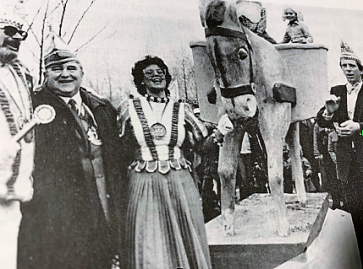Bechen donkey
Bernd Weber, Norbert Stannek, Dr., Rainer Stahlke, Dr.
Version from February 2021
The people of Bechen probably owe the name "Esel", or
"Aessel" as it is known in Bergisch Platt, to their stubbornness towards the feudal lords of Altenberg Monastery, to whom they were obliged to pay taxes.
Another version of the naming is more amusing and is often circulated by the Bechen carnival friends:
A long time ago, the farmers from Bechen took their donkeys to the market in Mülheim am Rhein to sell their goods. Although they set off at night because of the distance, they were often late because of the stubbornness of the gray animals. As they didn't want to take the unsold goods back to Bechen, they sold them for less than they were worth.
That's why the saying went around the market:
"Loss mer noch jett waade mem koofen, de Bechener Ässel sin noch nit do!"
"Let's wait with shopping, the Bechen donkeys aren't here yet!"
Of course, the other market farmers didn't like this, and it easily led to arguments and trades with the Becherer Asseln“.
From time immemorial, many places in the Bergisch region have had nicknames and epithets such as "Bechener Ässel" (Bechener Donkey), "Düscheder Mellsäck" (Dürscheider flour sack), "Kürtener Lüüs" (Kürtener louse), "Herkeroder decke Bunnen" and many more.... People cultivated local patriotism and defended their village against teasing and ridicule, as was also the case in Bechen. In the middle of the last century, it was still considered a test of courage for visitors from other villages to shout "IA" three times loudly on the dance floor. A wild brawl was already underway, resulting in injuries and often broken furniture.
Nowadays, things are more civilized. The tradition of the Bergisch dialect and the village nicknames is now cultivated by carnival clubs in many places.
The Karnevalsfreunde Bechen (KFB) have the donkey in their coat of arms, every carnival medal has a donkey in the motif and a donkey was already carried in the Bechener Weiberfastnachtszug in 1959. The Bechen donkey became very well known through the television broadcast of the 1960 Weiberfastnachtszug, led by the themed float "De Ässele kummen". The heraldic animal had established itself; no carnival medal without it, no stage set, poster, admission ticket, festival booklet or meeting decoration without it. In 1981, a life-size plaster donkey adorned the prince's float in the Weiberfastnachtszug. At the morning pint the next day, the board decided to erect the donkey as a monument in the parking lot in the center of the village; three days later on Rose Monday, the idea was put into practice. The response from the people of Bechen was overwhelmingly positive. But after almost 3 years in the "great outdoors", the plaster donkey had unfortunately crumbled. On the occasion of the proclamation in 1983, the then
pastor Lampenscherf
offered to donate 1000 DM if the KFB would erect a new, weatherproof donkey. Mayor Josten joined in with 500 DM. The project was launched and a life-size bronze donkey by the artist Heide Dobberkau was chosen for the then proud price of 25,000 DM. The KFB started a collection campaign in Bechen and contributed 5000 DM itself. The donkey was financed and on
August 20, 1983
it was erected and inaugurated on the village square, raised on a pedestal made of Lindlar graywacke.
People meet "at the donkey", it is a meeting point for young and old, hikers, bikers, motorcyclists, local clubs, bowling clubs and also serves as a popular photo motif.
The village's landmark is now known far beyond its borders and has become an integral part of our community.
Story about the Bechen donkey,
LOKALZEIT from Cologne (Source: YouTube)
Sources:
Josef Büchel, (editor): 800 Jahre Bechen, Festschrift 800 Jahre Bechen, 1975,
Bernd Weber: Where did the nicknames and epithets of the villages in the Bergisches Land originate?, Kürtener Schriften, Issue 7, Geschichtsverein Kürten und Umgebung, 2009
Bechener Eselspfad, IG Bechen, 2010,
Geschichtsverein für die Gemeinde Kürten und Umgebung e. V.: Von Wegekreuzen, Mühlen und Dolinen,- Kulturhistorische Zeugnisse in der Gemeinde Kürten - 2009



